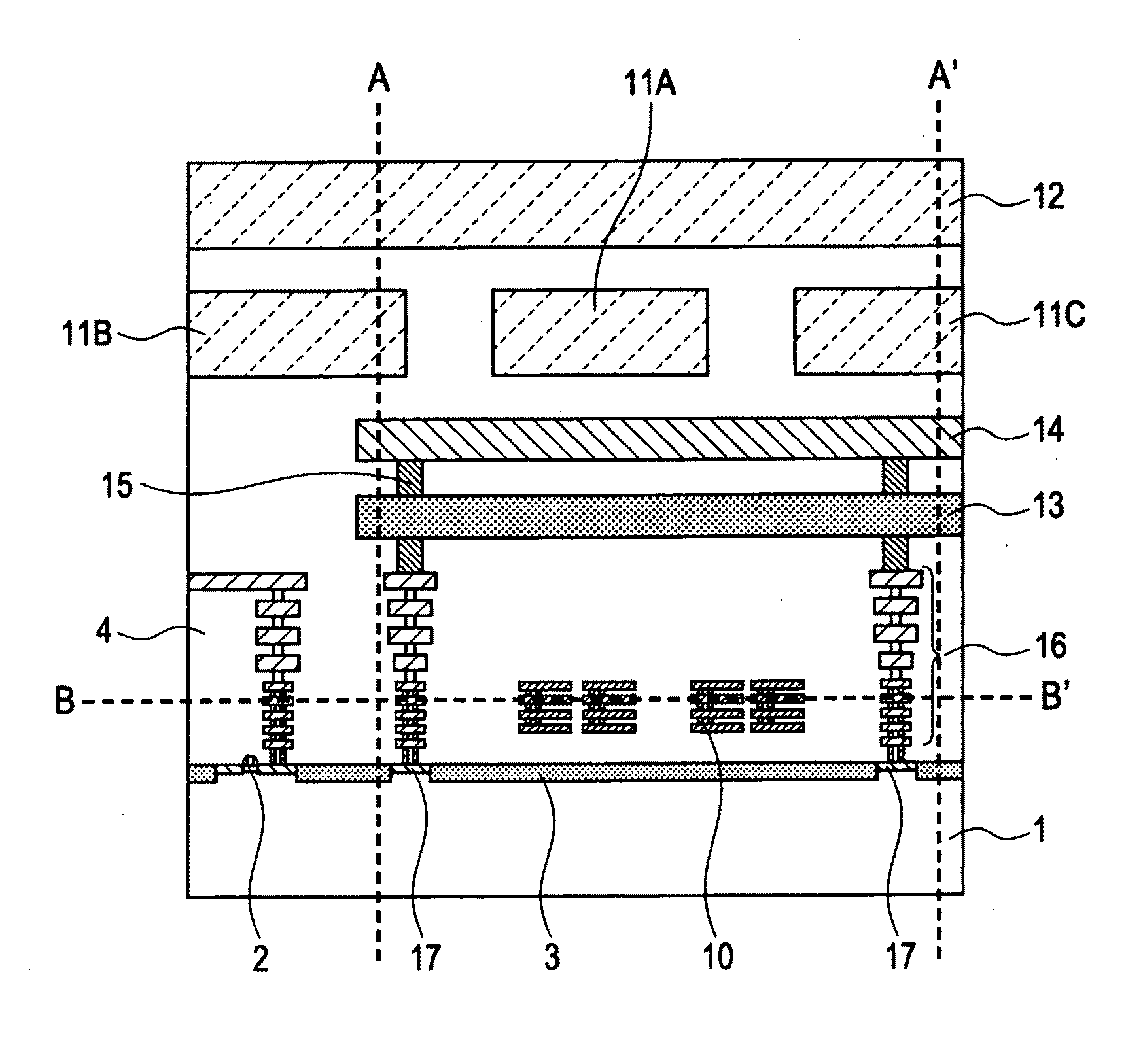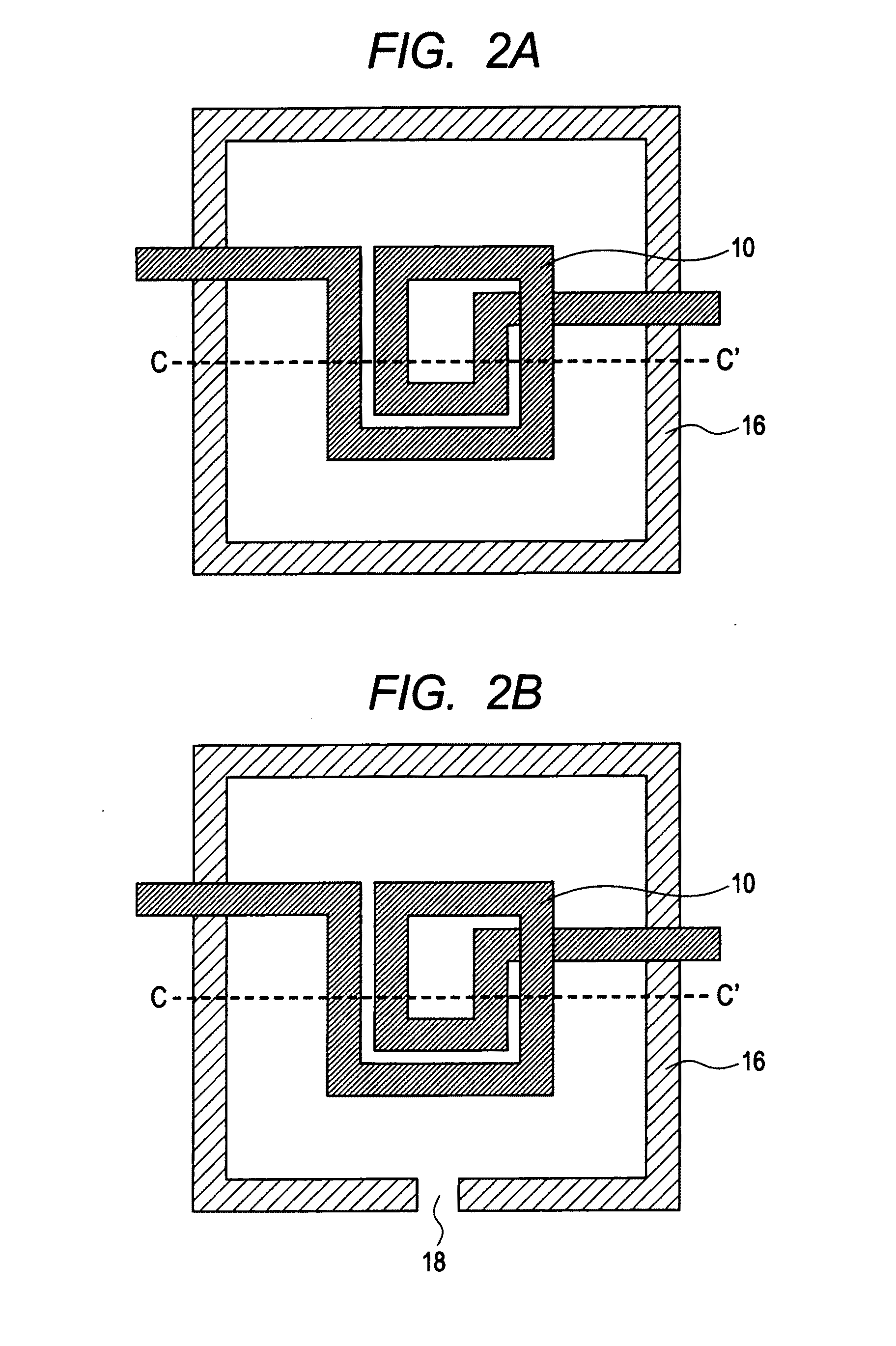Semiconductor device and semiconductor device manufacturing method
a semiconductor device and manufacturing method technology, applied in the direction of semiconductor devices, circuit arrangements on conductive chasis, basic electric elements, etc., can solve the problems of mutual interaction between the inductor elements, poor inductor element performance, circuit malfunction, etc., to reduce the design of the semiconductor device containing the inductor element, reduce the design freedom, and effectively suppress the mutual interaction
- Summary
- Abstract
- Description
- Claims
- Application Information
AI Technical Summary
Benefits of technology
Problems solved by technology
Method used
Image
Examples
first embodiment
[0049]FIG. 1 is a cross sectional view showing one diagrammatic example of the first embodiment. Examining FIG. 1 reveals that an active element 2, an element isolation region 3, and an interlayer dielectric film 4 are formed over a semiconductor substrate 1 the same as a typical semiconductor device; and multiple wiring layers are also formed within the interlayer dielectric film 4. The semiconductor device of the present embodiment in other words includes the semiconductor substrate 1, and multiple wiring layers (hereafter multi-wiring layers) formed over the semiconductor substrate 1. These multi-wiring layers contain an inductor element 10, the wires 11A through 11C, and the wires 12 formed above the inductor element 10, and the shielded conductors 13 and 14 at a fixed voltage potential and formed between the inductor element and the wires 11A through 11C and the wires 12 so as to cover the inductor element 10 as seen from a flat view. The “wires 11A through 11C” are sometimes h...
second embodiment
[0089]The second embodiment of the present invention is described next in detail while referring to the drawings.
[0090]FIG. 12 is a cross sectional view showing one example of this embodiment. The second embodiment is different from the first embodiment in the shielded conductor 21 positioned between the inductor element 10, and the wires 11 and 12 positioned above the inductor element 10 is single layer wiring. However aside from this point, the second embodiment is identical to the first embodiment so a description is omitted here as appropriate for purposes of simplicity.
[0091]The shielded conductor 21 is a pattern in which a slit is formed the same as in the shielded conductor 14 in the first embodiment. Multiple wires are formed in the slit, and the wiring may be formed at a right angle to the electrical current flowing in the inductor element 10 directly below the direction the wire extends (See FIG. 3). The shielded conductor 21 may be formed in a matrix pattern to enhance th...
third embodiment
[0098]The third embodiment of the present invention is described next in detail while referring to the drawings.
[0099]FIG. 14 is a cross sectional view showing one example of the embodiment. Among the shielded conductors formed from two-layer wiring in the example shown in FIG. 14, the shielded conductor 13 positioned in the lower layer is a shielded conductor formed as shown in FIG. 3 the same as in the first embodiment; and the shielded conductor 22 positioned in the upper layer is a shielded conductor containing a matrix pattern as shown in FIG. 15. Namely, unlike the first embodiment, the present embodiment contains at least one each of a “shielded conductor containing a matrix pattern” and a “shielded conductor” that includes shielded conductor wires electrically coupled to each other, and the direction that the wiring positioned in the area overlapping the inductor element 10 extends as seen from a flat view is approximately perpendicular to the flow of electrical current in t...
PUM
 Login to View More
Login to View More Abstract
Description
Claims
Application Information
 Login to View More
Login to View More - R&D
- Intellectual Property
- Life Sciences
- Materials
- Tech Scout
- Unparalleled Data Quality
- Higher Quality Content
- 60% Fewer Hallucinations
Browse by: Latest US Patents, China's latest patents, Technical Efficacy Thesaurus, Application Domain, Technology Topic, Popular Technical Reports.
© 2025 PatSnap. All rights reserved.Legal|Privacy policy|Modern Slavery Act Transparency Statement|Sitemap|About US| Contact US: help@patsnap.com



